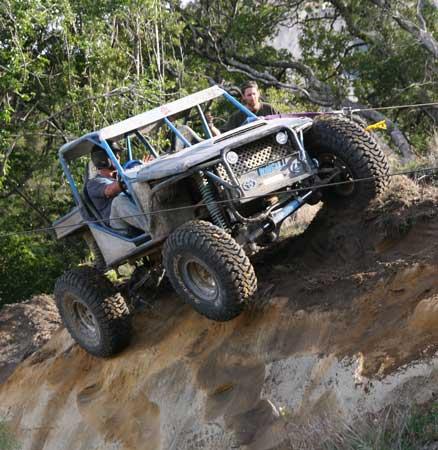|
Ron and Debbie Strume opened their gates to some of the local North Island 4WD Clubs for a two day teams recovery event during May, and members from the South Waikato 4WD Club, Bay of Plenty Four Wheel Drive Club and Eastern Bay Twin Diff Club took the opportunity to have a weekend away. There were a couple of faces from the National Trial Series including Graeme Kingstone who brought out the Cat Supercharged Toyota, Steve “the Pirate” Morley and brother Kevin in the Jeep Wrangler, and Pierre Le Lievre in the E class Suzuki. The rest of the vehicles were made up of club “bush trucks”. Every vehicle has two occupants – driver and runner – and as the name suggests the runner does not spend much time inside the vehicle - in fact if he is found inside a moving vehicle during the timed hazard, penalty points are added to the team’s score. On average a hazard will take between 45 minutes to an hour or more to complete. There is no easy set track to follow and drivers must negotiate vehicles between the pegs over the terrain and under the direction of the runners. The objective is to get the team of all three vehicles through the entire hazard in the fastest time - seems simple enough. They are allowed to survey the entire hazard on foot before starting, picking points and checking terrain durability. If they are really lucky the organisers will help by setting up a permanent anchor point. The most time consuming part is setting up of the gear and changing the equipment between the trucks. They can only use what is on board and no outside assistance is allowed. Safety is paramount and time keepers will shout at anyone who is inside the danger zone or parameters. A vehicle can leave the hazard at any time from anywhere, but they must re-enter the stage at the same point they exited and every vehicle must put its hubs through the blue finish pegs. Basically everyone starts seated and belted inside the vehicles, the clock starts, the runners jump out, grab the ground anchors, hammers, and pulley blocks, and set up a cable system that will attach to two trucks, or three, depending on the weight of the vehicle needing to go up the hill or to be lowered down a bank. There were “reserve” vehicles brought in to substitute those which lost fuel while sitting on their side or misfiring vehicles which lost drive or pressure. It is not generally a spectator or open-to-the-public sport, but members from the clubs, spouses and family form the cheer squad on the sidelines. Eastern Bay Twin Diff Club A Team won this event and the trophy will be up for grabs again in the following weeks when South Waikato Club hosts the next one. |
The equipment. You may think a winch would be of some benefit to the situation but not so in this case. When you have three vehicles, an undrivable hole, cliff face or hill, the best equipment for the job includes really big sledge hammers, D shackles, pulley blocks, a few hundred metres of cable, a Kito clip, and ground anchors – not the ones you see in winch challenge competitiond either. After years of development the guys have found the most effective design for a ground anchor in this situation is like a cobweb. Three or four half metre steel pegs are angle punched into the ground and hold the four different wire strands in place. The Kito clip is a fixture for wire ropes and it is used to lock the wire from the reel to the vehicle to prevent from free spooling. |




